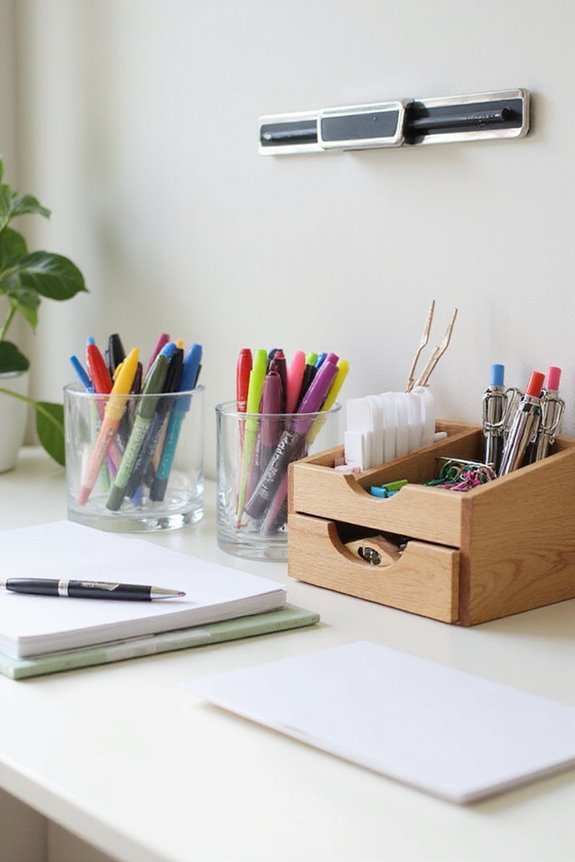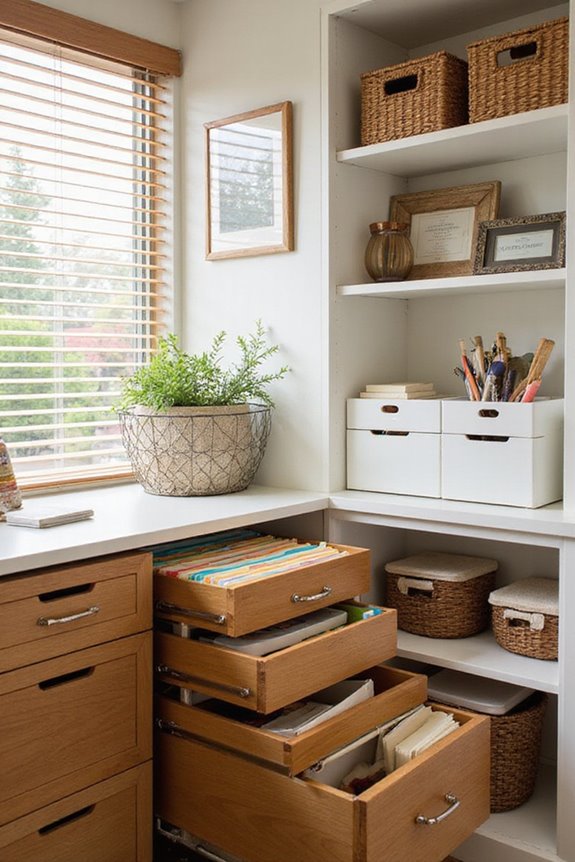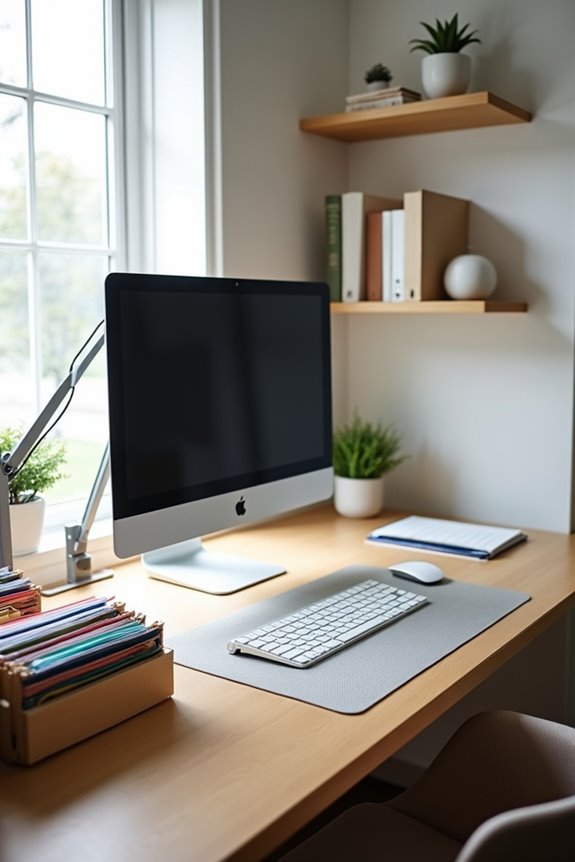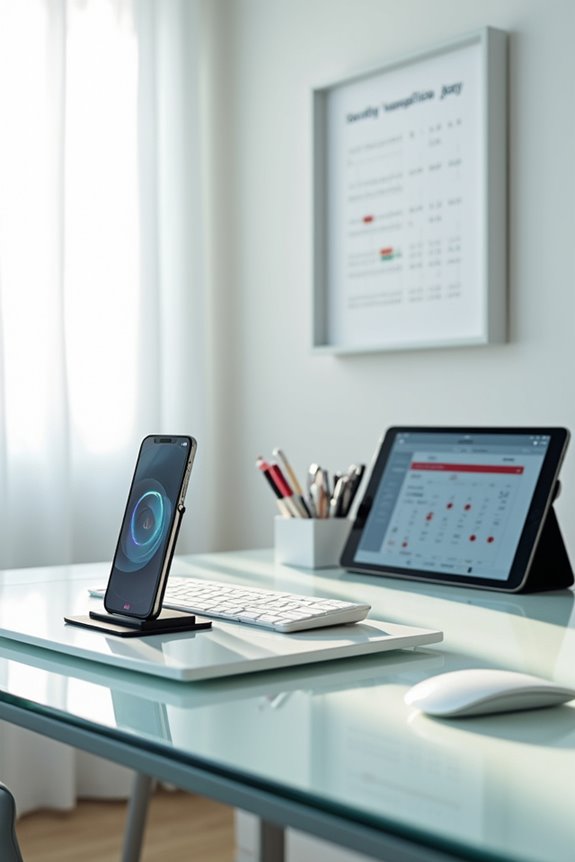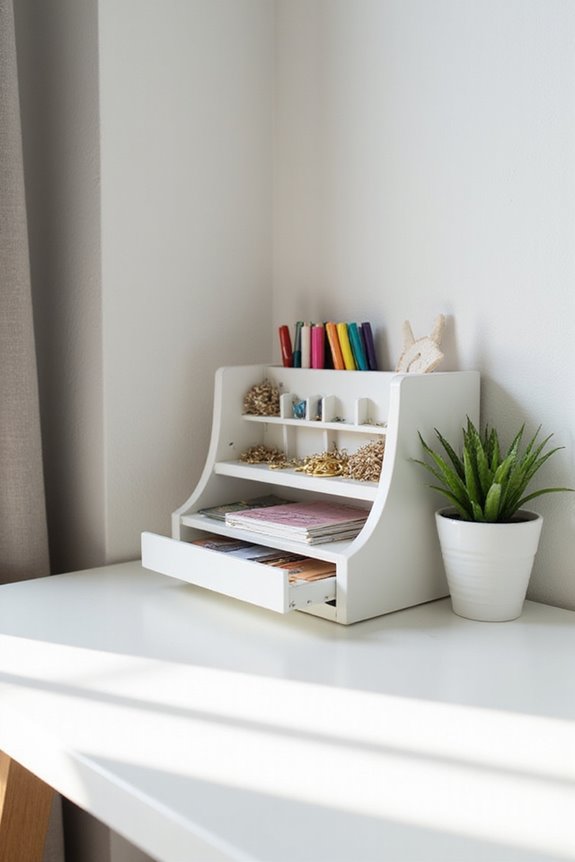To organize pens and writing supplies effectively, I recommend starting with ergonomic pen selection, choosing those with contoured grips and balanced weight for comfort. Next, explore various materials, from durable metal to eco-friendly options that align with your values. Group pens by color for a visually appealing system and consider effective storage solutions, like zippered cases or wooden crates, for accessibility. Implementing labeling can further enhance organization. If you want more tips on managing your supplies efficiently, continue exploring.
Key Takeaways
- Use color coding to differentiate pen types and tasks, enhancing organization and efficiency in your workspace.
- Choose storage solutions like zippered cases or roll-up cases for compact and secure pen organization while traveling.
- Opt for space-saving designs such as wooden crates or DIY boxes to maximize storage in limited areas.
- Maintain a limited color palette for pens to create visual cohesion and reduce clutter in your writing supplies.
- Regularly declutter and assess your pen collection to ensure only functional and necessary items are kept.
Ergonomic Considerations for Pen Selection
When selecting an ergonomic pen, it’s essential to contemplate several key factors that can greatly impact your writing experience. First, consider pens with contoured grips, as they provide ergonomic grip benefits by reducing strain on your hand. Cushioning on the surface can also absorb pressure, enhancing comfort during long writing sessions. Additionally, balanced weight distribution is vital for minimizing fatigue.
Another important aspect is the design of the pen. Angled barrels promote writing posture improvement, allowing for a more natural wrist position. If you have specific needs, adjustable grips can accommodate various hand sizes. Overall, investing in an ergonomic pen can markedly enhance your writing experience while promoting long-term health benefits. Additionally, selecting pens with various tip sizes allows for versatility in your writing style and comfort.
Exploring Material Variance in Pens
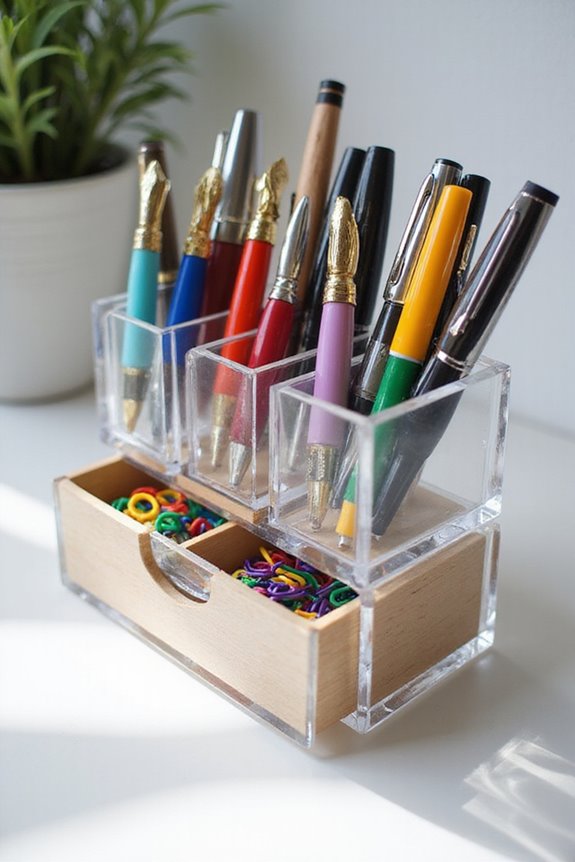
As we explore the world of pens, understanding the materials used in their construction can greatly influence our writing experience. The three common materials—metal, wood, and plastic—each offer unique characteristics. Metal pens excel in material durability, making them resistant to wear. In contrast, wood pens provide a lightweight option with a smoother grip but may suffer from ink flow issues. Plastic pens are cost-effective and versatile, though traditional plastics can be less eco-friendly.
For those concerned about sustainability, eco-friendly materials like recycled plastic, bamboo, and wheat straw are excellent alternatives. These options not only reduce environmental impact but also promote responsible consumption. By considering these factors, you can select pens that enhance your writing experience while aligning with your values.
Understanding Brand Preferences
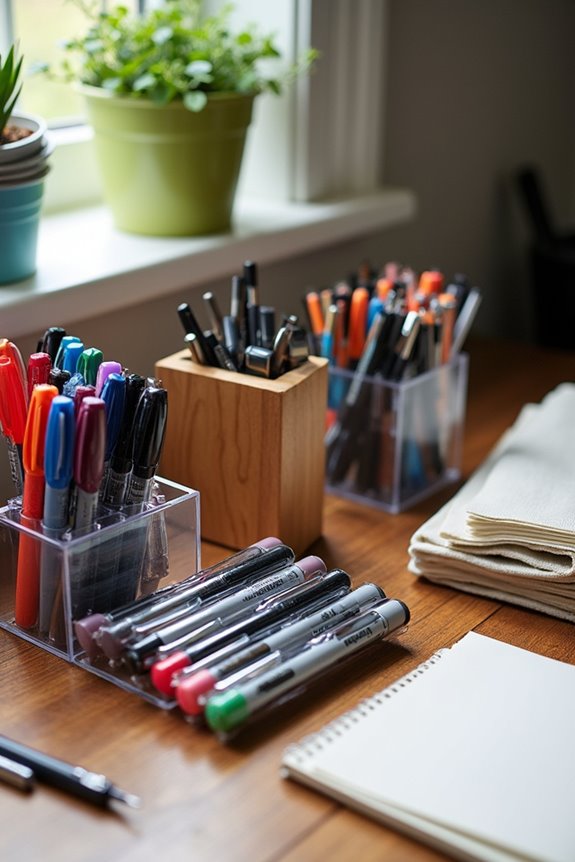
The materials used in pens not only affect their performance but also play a considerable role in shaping brand preferences among consumers. I’ve noticed that brand loyalty often stems from the consistency in performance and ink quality. For instance, luxury brands like Montblanc appeal to those seeking status, while everyday options like Bic are favored for their affordability and reliability.
Consumer trends show a growing interest in sustainable, reusable pens, particularly among eco-conscious buyers. Students and office workers typically gravitate toward budget-friendly choices, while collectors may seek trendy designs. Ultimately, factors such as design, ergonomics, and peer recommendations considerably influence brand selection, guiding us through the diverse pen market landscape.
Choosing the Right Color Options
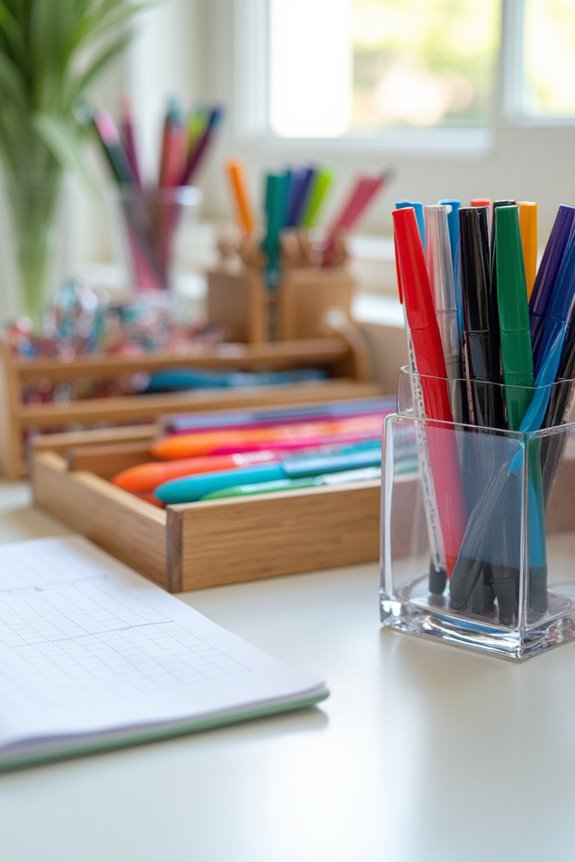
Selecting the right color options for your pens and writing supplies can greatly impact both aesthetics and functionality in your workspace. Understanding color psychology can enhance your productivity; for instance, blue pens may promote calmness, while red can stimulate energy.
To achieve aesthetic balance, consider organizing your pens using a limited color palette. This creates a cohesive look and reduces visual clutter. Arranging pens in a color gradient adds an artistic touch, while utilizing color coding systems can help differentiate between pen types and tasks.
Using neutral backgrounds allows your colored pens to stand out, enhancing visual clarity. By thoughtfully choosing colors, you can cultivate a workspace that inspires creativity and maintains organization.
Utilizing Specialty Pens for Specific Tasks
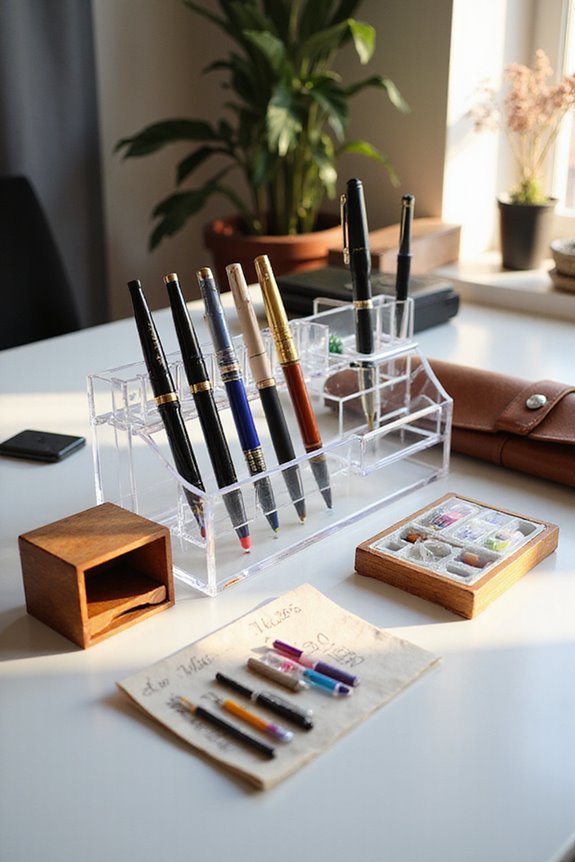
Utilizing specialty pens for specific tasks can greatly enhance both your efficiency and creativity in various settings. For instance, gel pen applications are perfect for artistic expression and colorful note-taking. I often use gel pens for creating vibrant designs and sketching preliminary layouts for projects.
On the other hand, the highlighter benefits are invaluable for emphasizing key information in my notes and documents. They help me quickly identify important points during study sessions and document reviews.
Effective Storage Solutions for Pens
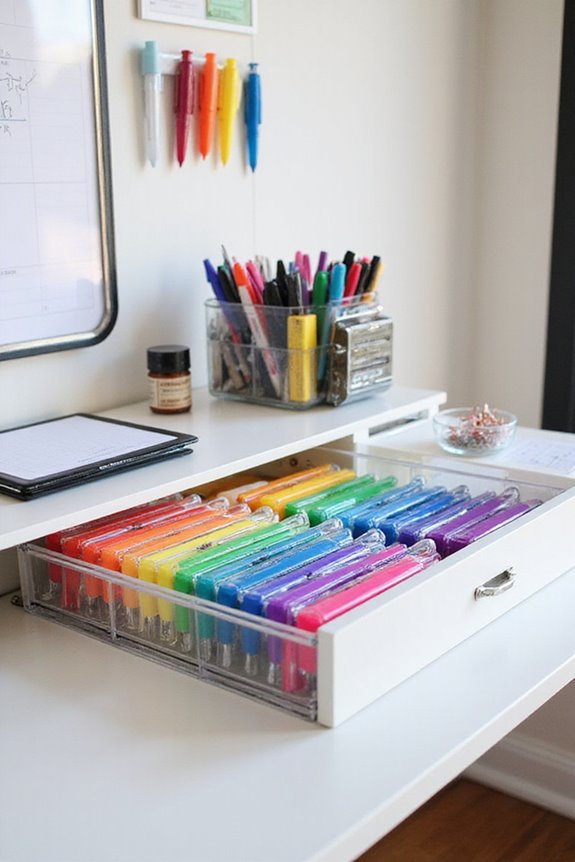
When it comes to organizing pens, having the right storage solution can make all the difference. For effective storage, I recommend options that feature space-saving designs and aesthetic appeal. The Monteverde 36-Pen Zippered Case is a fantastic choice for high-volume storage, while the Galen Leather 40-Pen Case combines compactness with style. For a more rustic vibe, consider using wooden crates or DIY cardboard box organizers.
If you’re looking for a workspace solution, a BLU MONACO Natural Wood Desk Organizer offers both functionality and charm. Additionally, selecting organizers made from durable materials can ensure long-lasting use and stability. Finally, for travel, a roll-up pen case provides compact and secure storage. Each of these options not only keeps your pens organized but also enhances your workspace’s overall look.
Implementing Labeling and Signage Systems
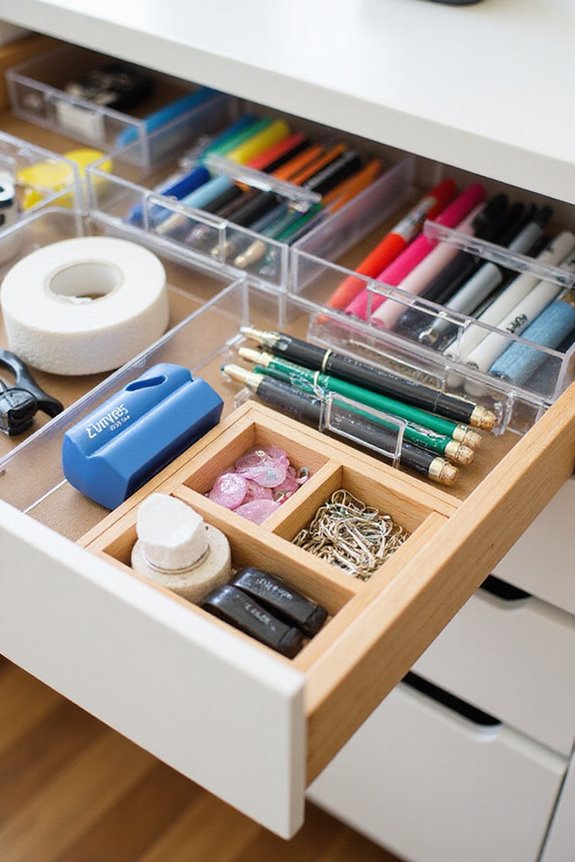
Organizing your pens and writing supplies is only the beginning of creating an efficient workspace. Implementing effective labeling techniques can drastically enhance your organization. I recommend using color-coded labels for rapid identification and removable labels for easy updates as your supplies change. Barcode labels can help with digital tracking, while QR codes can direct you to additional resources with a quick scan.
In larger workspaces, signage effectiveness is essential. Directional signs can guide new staff to supply locations, and instructional labels can clarify organization procedures. Ensuring consistency in label design and visibility will improve overall clarity. By thoughtfully integrating these systems, you’ll reduce search time and support a more organized and professional environment.
Maintenance and Cleaning Practices
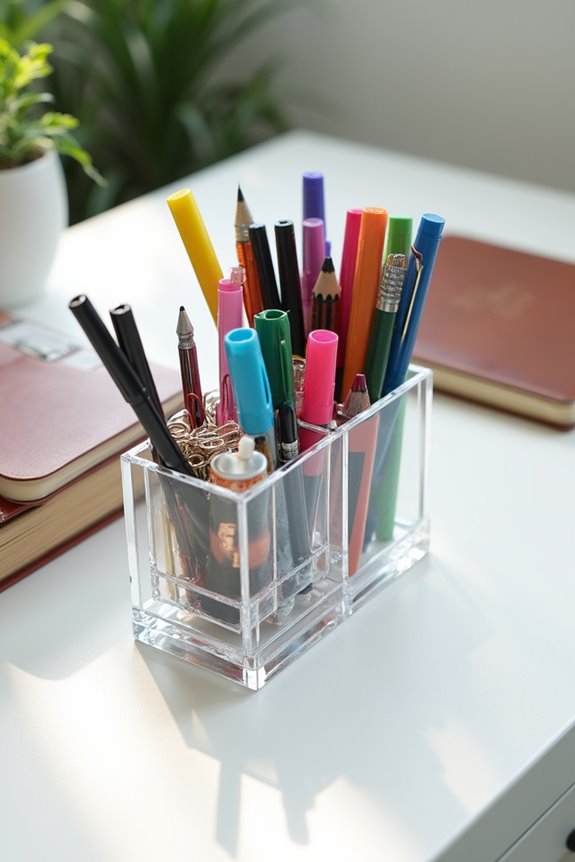
To maintain an efficient workspace, it is essential to establish consistent cleaning routines for your writing supplies. I recommend creating cleaning schedules that occur at least monthly, guaranteeing that every pen holder and organizer tray gets attention. For high-traffic areas, increase cleaning frequency to prevent dust buildup. During each cleaning session, I conduct supply inspections to check for leaks or damage, promptly recycling any unusable items.
Using microfiber cloths, I wipe surfaces without scratching, while compressed air canisters help dislodge dust in hard-to-reach spots. A checklist is handy for tracking the cleaning of every tool. By keeping records of cleaning dates, I maintain accountability and guarantee a hygienic workspace that supports my writing productivity.
Strategies for Supply Management
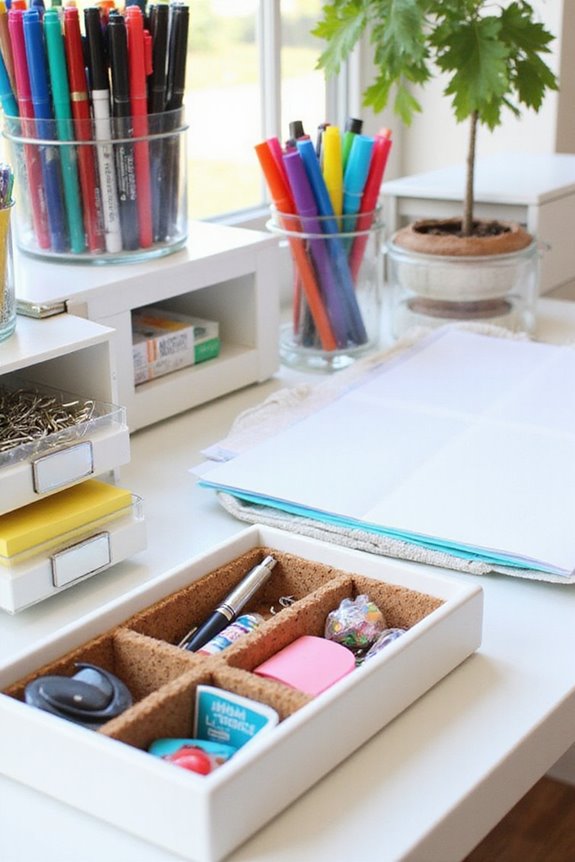
Effective supply management plays an essential role in maintaining an organized workspace that supports productivity. To achieve this, I focus on a few key strategies. First, I optimize my space by using vertical storage solutions and clear labeling systems for easy identification. I categorize supplies by type, ensuring frequently used items are within reach.
For effective inventory management, I rely on supply tracking to monitor usage patterns, allowing me to predict future needs. Implementing automated reorder systems helps maintain ideal inventory levels without excess. Additionally, I maintain detailed inventory logs and utilize digital tools for streamlined management. By fostering strong supplier partnerships and considering bulk purchases, I can further enhance my supply chain efficiency, ensuring I always have the necessary materials on hand.
Frequently Asked Questions
How Often Should I Replace My Pens?
I usually replace my pens based on their lifespan and ink quality. If they start leaking or writing unevenly, it’s time for a change. Regular checks help me guarantee I’ve got reliable writing tools.
What Is the Best Way to Clean Ink Stains?
When tackling ink stains, I’ve found effective ink removal techniques like rubbing alcohol work wonders. Plus, I always use stain prevention methods, like carrying hand sanitizer, to avoid future mishaps on my clothes.
Can I Store Pens Vertically or Horizontally?
Imagine a library of ink, each pen a storyteller. I’ve learned that vertical storage keeps their tales flowing, while horizontal storage preserves their wisdom. Choose wisely, or their stories might fade into silence.
How Do I Prevent Pens From Drying Out?
To prevent my pens from drying out, I focus on proper pen storage and ink preservation. I rotate usage, keep them capped, and store them horizontally to maintain moisture and guarantee smooth writing experiences.
What Are the Benefits of Using Refillable Pens?
I’ve found that using refillable pens really boosts cost savings while also making a positive environmental impact. They cut down plastic waste and save money in the long run, which feels great for both my wallet and the planet.

